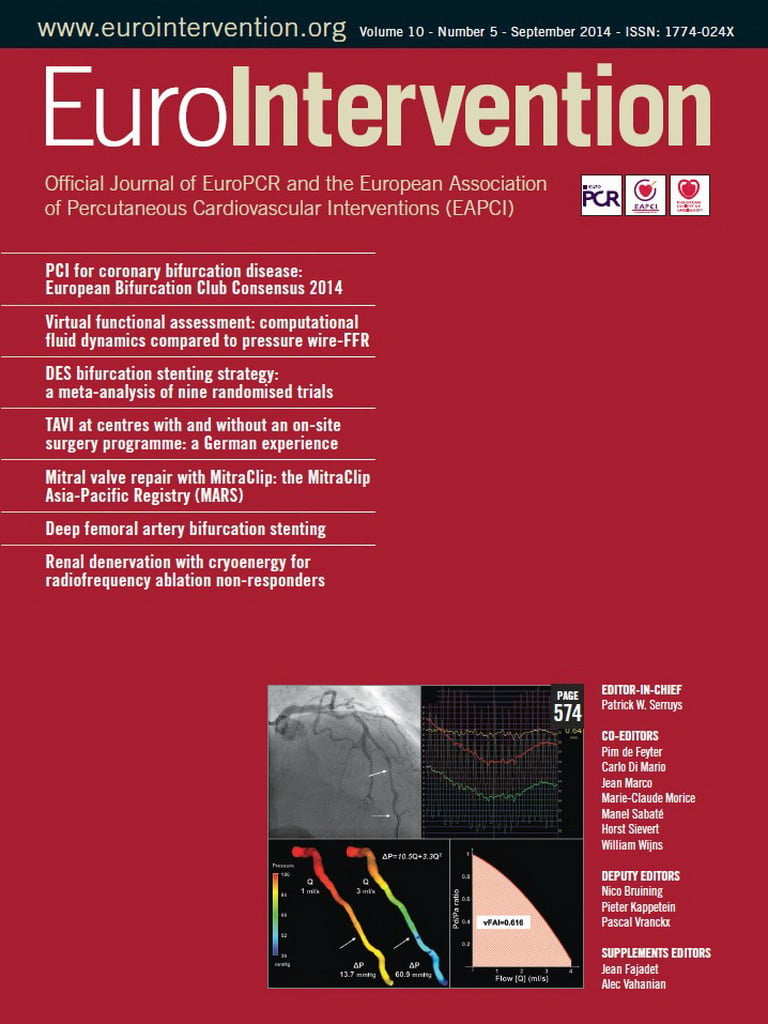“Thou shall not”……unless “thou” art in Germany!
The first commandment of transcatheter aortic valve implantation (TAVI) is that it should not be performed in the absence of an on-site cardiovascular surgery department. This position is enshrined in various recommendations and statements of national and international cardiology societies1-4. Although seemingly pedantic, it is important to distinguish between an “on-site surgical department” and “on-site surgery”. For the purposes of TAVI, the latter insinuates availability of surgical “back-up” for vascular access and/or the management of procedural complications, while the former implies a far more substantial contribution to patient care. On-site cardiovascular surgery departments optimise TAVI care by enhancing (1) patient selection and procedural planning, (2) procedural performance, and (3) management of complications and post-procedural care.
In this month’s issue of EuroIntervention, Eggebrecht and colleagues present an intriguing comparison of TAVI outcomes among patients treated either in hospitals without an on-site cardiovascular surgery department or in traditional medico-surgical centres5. The authors are to be congratulated for highlighting this controversial practice in Germany where, among 1,432 patients enrolled in the German TAVI registry, 178 (12%) were treated either in a typical medico-surgical centre by a visiting TAVI operator (n=129) or “off-site” in a non-surgical centre with a visiting surgical team (n=49). Theoretically, a TAVI operator visiting an existing medico-surgical site will benefit from the availability of the existing TAVI Heart Team, while an operator performing TAVI in an “off-site” non-surgical site will not. Statistical comparisons between groups are not presented, due to the high likelihood of selection bias, but the data presented suggest that patients treated “off-site” were a less challenging cohort, which had protracted procedures yet similar clinical outcomes to TAVI recipients from traditional medico-surgical centres.
It is intriguing to examine the motives behind the development of this novel treatment pathway. Potential advantages of “off-site” TAVI include the provision of a more expedient, familiar and localised service for the patient, and the development of new skills benefiting the physician and/or parent institution. In geographically isolated areas or in healthcare systems where access to TAVI may be restricted by geographic location, such benefits are amplified. Germany is not such a healthcare system6, and therefore one must consider personal or institutional financial gain, prestige, or other such motives for the emergence of this practice pattern.
Centralisation of care for high-risk patients and complex interventions is recommended based on accumulating evidence of lower patient mortality associated with high-volume institution care across multiple clinical conditions and care settings7-9. Luft described this effect as the “practice-makes-perfect hypothesis”9. In the current manuscript, low procedural volume was reflected by longer operative times in “off-site” cases, despite an apparently lower-risk cohort. TAVI should not be performed, in any setting, without appropriate team training, sufficient procedural volume, and demonstration of outcomes similar to national benchmarks3. We are not informed as to the TAVI case-volume at “off-site” institutions; however, a minimum of 20 cases per annum has been proposed as the requirement to maintain operator competence3. Participation in national registries and publication of outcomes should be obligatory to prevent the concealment of poor results or abnormal practices.
Eggebrecht et al do not provide specific information regarding the operation of the inter-institutional Heart Team. When isolated, cardiologists and cardiac surgeons can provide conflicting information to patients, and bias decision making towards a specific intervention10. The Heart Team approach is recommended in societal guidelines1,2, is thought to enhance patient selection, procedural planning, and postoperative care, and is thus central to improving patient outcomes11,12. Ensuring the veracity of the Heart Team discussion is axiomatic; however, the current study raises interesting questions regarding the format of such meetings: can Heart Team discussions be performed at a distance? Mobile solutions can provide an alternative to a physical presence at the weekly TAVI multidisciplinary conference and are frequently used for patient screening in randomised trials13. Thus, it may be feasible to have high-quality Heart Team meetings in the absence of an on-site cardiovascular surgery department, potentially yielding other ancillary benefits, such as greater inter-institutional collaboration.
Despite the relative maturity of the technique, TAVI remains a relatively complex procedure that can present life-threatening complications. The reported requirement for emergent cardiac surgery is variable (1-5%)14,15, though it is expected to decrease over time with improved operator experience, procedural planning, and the advent of repositionable TAVI systems. It is not yet appropriate to draw parallels with the development cycle of percutaneous coronary intervention, as the multiplicity and gravity (mortality rates approaching 50% for emergent surgery with TAVI14,15) of TAVI complications necessitates the presence of a cardiovascular surgery department for both expedient operative intervention and ongoing postoperative management. As TAVI technology is applied to lower-risk cohorts, the availability of such services will become of even greater importance. Whether a mobile surgical team can provide operative intervention with the same level of expediency and skill in an unfamiliar environment is unclear16. Furthermore, it remains unclear how patients would receive ongoing expert postoperative surgical care when the visiting surgical team has departed.
The study by Eggebrecht et al provides insight on many levels. In particular, it highlights further the unchecked nature of TAVI proliferation in Germany: in 2011, Germany had more than double the TAVI implant rate of all other European nations except Switzerland and 14 times the implant rate of Ireland and Portugal17; a 2009 publication from the German TAVI registry reported that 13% of patients received TAVI as a result of patient choice18. The relative trade-offs between performing TAVI in a traditional medico-surgical centre compared to a non-surgical centre with a visiting surgical team must be based on clear evidence of clinical equipoise between treatment pathways. The data presented by Eggebrecht et al do not provide such evidence, but rather initiate a dialogue that will undoubtedly endure for the foreseeable future.
Conflict of interest statement
N. Piazza is a consultant and proctor for Medtronic. The other authors have no conflicts of interest to declare.

